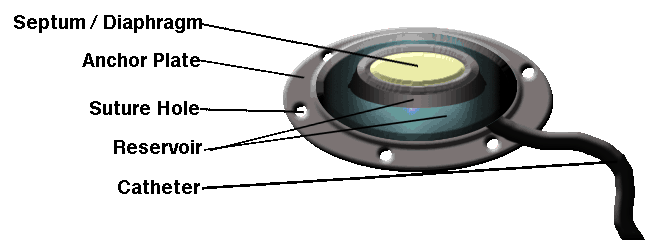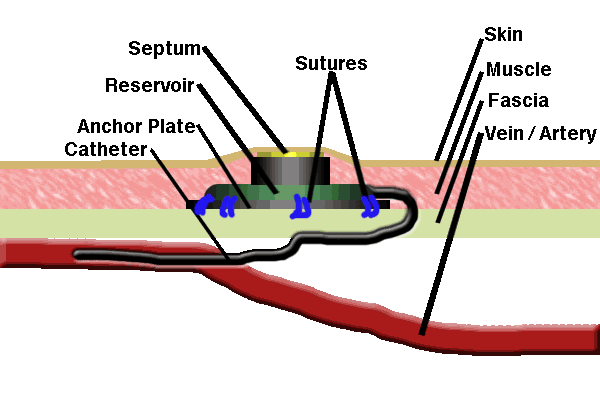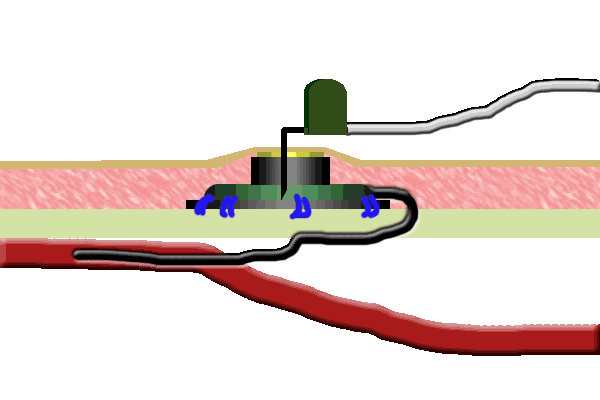What is a port? |
 |
Ports are a long-term form of Central Venous Access Devises (CVADs). Normally, these are small devices that can be implanted under the skin to allow easy access to a person's circulatory system. Having a port can prevent undue wear and tare on a person's peripheral veins as well as make venous access much easier if those veins are not large and easily visible.
The Port/CVAD essentially provides a larger and easily distinguishable target that will not move when an IV needs to be started or blood needs to be drawn. Ports can make life much easier for many people with chronic conditions requiring frequent vein accesses for blood draws and/or medications.
This convenience comes at a price through. People who have ports must stay vigil as ports have an increased risk of infection and require more routine maintenance than starting a new IV whenever access is needed.

(The above image is enlarged for easy viewing. The size of a port or
CVAD is normally larger than the size of a quarter and smaller than
a 50-cent piece.)
The Anchor Plate and Suture Holes are basically self-explanatory. When the port is being implanted, the surgeon will use the holes in the anchor plate to suture the port in a specific place, preventing it from moving within the person's body over time.
The Reservoir is simply the area were fluid exchange actually takes place. It is inside the reservoir that medications actually leave the needle and enter the body.
The Catheter is a tube that connects to the port's reservoir and is surgically inserted into a vein or artery. Medications flow from the port, through the catheter and directly into the blood stream. In some cases ports can also be used for blood draws, at which point the process is simply reversed, blood is pulled through the catheter, into the reservoir and out through a needle.

The implantation of a port is a surgical procedure and thus should be preformed in an operating room. The procedure begins with the surgeon thoroughly cleaning the area when the catheter and port will eventually be inserted. The vast majority of ports used in the bleeding disorders community are now placed in the chest and accesses the subclavian vein. Older patients are normally only given local anesthetics but anesthesia is often used in children to prevent complications that can be caused by movement during the procedure.
Once the area has been prepared (cleaned and numbed) a small incision is made and a needle is inserted into the subclavial vein followed by a guide wire and the catheter. The catheter is then slid inside the vein until it reaches the heart's right atrium. With the catheter in place, the surgeon removes the guide wire and feeds the now free end through the various layers of muscle between the vein and the new port location and connects it to the port reservoir.
Next the surgeon creates a pocket in subcutaneous tissue on the chest wall that will hold and cushion the device and places the port in its new home. With everything in place, the surgeon attaches the port to the fascia (connective tissues that enclose the muscles) using permanent sutures to prevent the port from moving and flipping over.
The original incision is stitched closed and the procedure itself is complete.
After the port surgery is complete, it is suggested that the site be kept covered for 48 hours with sterile dressings to prevent infection. After the skin has healed the dressings can be removed, as the layer of skin will prevent infection due to environmental conditions.
Directly after the surgery and for the next week or so it is very important to pay attention to your port and signs of infection. Port infections are very serious matters. Since the catheter leads directly to the heart port infections can spread throughout the entire body very quickly.
Some signs of infection to watch for include:
- The area around the port becomes red.
- The area around the port becomes hot to the touch.
- The area around the port becomes increasingly tender.
- You begin running a fever.
- You notice swelling around the port.
- You begin seeing fluid draining from the site.
It is very important to maintain your port through regular heparin flushes and alerting your provider(s) if you see anything out of the ordinary. As a rule of thumb, ports should be flushed with heparin after each use regardless of the port location. On top of the flushing each use, it is a good idea to flush a port with heparin at least once a month if the catheter is placed in a vein, and at least once a week if it has been placed in an artery.
Depending on the type and location of the port the care recommendations can vary. You should consult your physician for the optimal care guidelines for your exact situations.
Port Flushing Procedure
Supplies:
1) Sterile Field
2) Alcohol Wipes
3) Povidone-iodine swabs
4) Sterile Gloves
5) Prefilled Saline Flush Syringe
6) Syringe of Heparin Flush
7) Huber (Gripper) Needle
8) Adhesive BandageProcedure:
1) Wash hands thoroughly and place a sterile field on the surface you will be using to lay out supplies. (The sterile filed helps prevent contamination of material for the surroundings.)
2) If the needle hurts or bothers the individual being accessed a topical anesthetic can be applied to give some comfort.
3) Clean the port site and surrounding area with alcohol wipes, followed by Povidone-iodine and allow to dry.
4) After putting on your rubber gloves, attach the gripper needle to your saline flush syringe.
5) Slowly push the plunger until a drop of saline can be seen forming on the tip of the needle.
6) Feel for the port under the skin and push the needle through the skin and septum at a 90-degree angle with the septum. Insertion of the needle should not stop until it has come into contact with the metal plate that forms the back of the port. (Illustrated Below)
7) Pull back on the plunger until you see blood starting to be drawn from the port. This ensures that needle is positioned correctly in the port, and the catheter is free of clots. (This step may not be possible if the port accesses an artery instead of a vein.)
8) Steadily push the plunger forcing the saline out of the syringe and flushing the port.
9) Once the saline flush has been completed, unhook the saline syringe from the needle and attach the syringe of heparin.
10) Press the plunger on the heparin syringe to flush the device with heparin.
11) While holding the port into the chest wall with one hand, grip the needle with the other hand pull it out.
12) Paint the area again with povidone-iodine and cover with an adhesive bandage.
Accessing a Port
To administer medication through a port, a very similar procedure is used as was discussed in the Port Flushing Procedure. The only difference is additional steps that need to be added between steps 8 & 9.
Those steps are:
8.1) Once the saline flush has been completed, unhook the saline syringe from the needle and attach the syringe or bag of medication that needs to be administered.
8.2) After the medication has been fully infused, unhook the medication from the needle and attach another saline flush.
This means that the port should be flushed with saline both before and after medication is given through it.

Q: Can I go swimming
if I get a port?
A: Yes, since the port is placed
under the skin it is well protected from environmentally caused infections.
Having a port should not make any difference as to what a person can
or cannot do. Swimming should be avoided for the first two weeks after
the surgery though in order to allow the wound to heal.
Q: Can I shower after
having port surgery?
A: Yes, showering should not
be a problem as long as you cover the site with an appropriate dressing.
Typically, after three days the wound has healed enough for showers
to be taken without the dressing. Baths, however, where the wound can
become submerged should be avoided for at least two weeks.
Q: What happens if my port becomes infected?
A: That depends on the nature
of the infection. If the infection is caught early enough and is inside
the port, most infections can successfully be treated with antibiotics
given directly through the port. If the pocket on the chest wall becomes
infected the port must be removed.
Q: Can a port be removed once it has
been implanted?
A: Yes, ports
are frequently removed for various reasons. Removing a port does mean
going back into the operating room where a surgeon will remove the port
& catheter, using sutures to mend the vein, pocket and skin.
Q: Will my port interfere
with me getting an MRI?
A: Possibly. There are many variables
that need to be taken into account in this answer. Since the port has
metal in it and MRIs use strong magnetic fields to create the images
it depends on the part of the body that is getting scanned (and its
proximity to your port) as well as the strength of the magnetic field
being used. You definitely should check with your doctor and make the
facility and technician performing the MRI aware of the port.
Q: Will my port set
off the metal detectors at airport security?
A: Most metal detectors used
in the airports are not set sensitive enough to detect ports however,
if the detector is set to be sensitive it definitely can get set off
by a port. It is a good idea to have a travel letter from your doctor
that explains the port, just in case.
Q: How long do ports
last before having to be replaced?
A: There is no set expiration
date or time limit on a port. Ports implanted in children may need replacement
if the child outgrows the catheter.
Sources:
National Institutes of Health
Smith's Medical
University Hospital and Clinics, Madison, WI
Total Parenteral Nutrition Team at Medline Plus
University of Pittsburg, Medical College